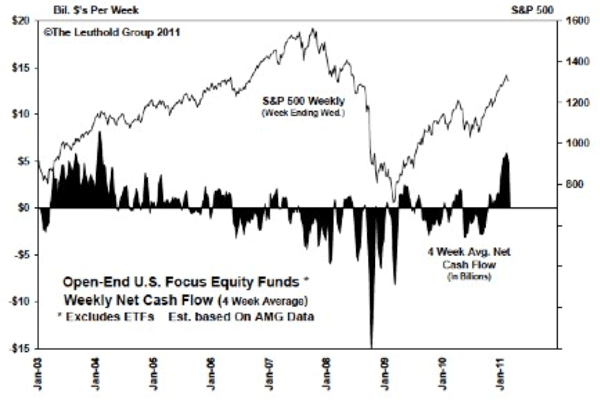The Art Of Buying High And Selling Low
That’s right! Buying high and selling low! Sound backwards? You may be surprised to discover that’s actually what most retail investors do. The chart below from the Leuthold Group, an institutional research firm, compares the timing of inflows and outflows to/from US equity mutual funds to the price of the S&P 500. Since most retail investors use mutual funds to invest in the market, it’s a good proxy for determining when they are buying and selling.

You can see that there was more selling at the market bottoms in 2008 and 2009 than at any time in the last 9 years. And when did much of the buying start again? Not until this year, after the market had already bounced back over 75%. Even now, investors are sitting on a record $5.9 trillion in liquid deposits in domestic accounts, according to Dan Geller of Market Rates Insight.
Study after study confirms that do-it-yourself investors commonly buy and sell at the wrong times. Don Phillips, writing in Morningstar Advisor magazine, believes investors “cut off 1 to 2 percentage points per year from their return by piling into asset classes at their peaks and deserting them at their troughs.” Common sense tells us this is wrong – the best way to make money in the stock market is obviously to buy low and sell high. So why don’t most investors do that? It’s because as human beings, we often make financial decisions based on emotion rather than on rational objectivity. Can you remember a time when your brother-in-law told you he made 30% on his Apple stock investment in only three months? Didn’t that make you want to run out and buy Apple, either to get a piece of that kind of return or maybe just to put a stop to his annoying bragging? Or think back to March 2009. The market had crashed six months earlier and was now plunging toward new lows. The media was predicting the possibility of another thousand-point drop for the Dow. How many people sold their mutual funds at that time, thinking they just can’t deal with the risk and the stress anymore? According to the chart, a lot.
The best way to avoid buying high and selling low is simply to stop trying to time the market and do what most financial planners advise: develop an investment strategy involving predetermined allocations to stocks, bonds, and other asset classes that are relatively uncorrelated with each other. If you are holding a lot of cash right now in money market funds, CDs, or bank accounts, you can use dollar cost averaging to slowly get back into the market to avoid the risk of buying in right before any downturns.
Why can’t you just keep your money in cash accounts and forget about the stock market? Well, if you think stocks are risky, “liquid accounts are a sure loser right now,” says Geller. Money in these types of accounts is currently earning an average of 0.4% interest. By comparison, the annual inflation rate last year was 2.1%. At that rate you’d be losing 1.7% of the value of your cash each year. That’s no way to save for retirement.
Buying low and selling high would be a successful way to invest. But following a strategic investment discipline is easier and potentially even more successful, especially for the long run.
